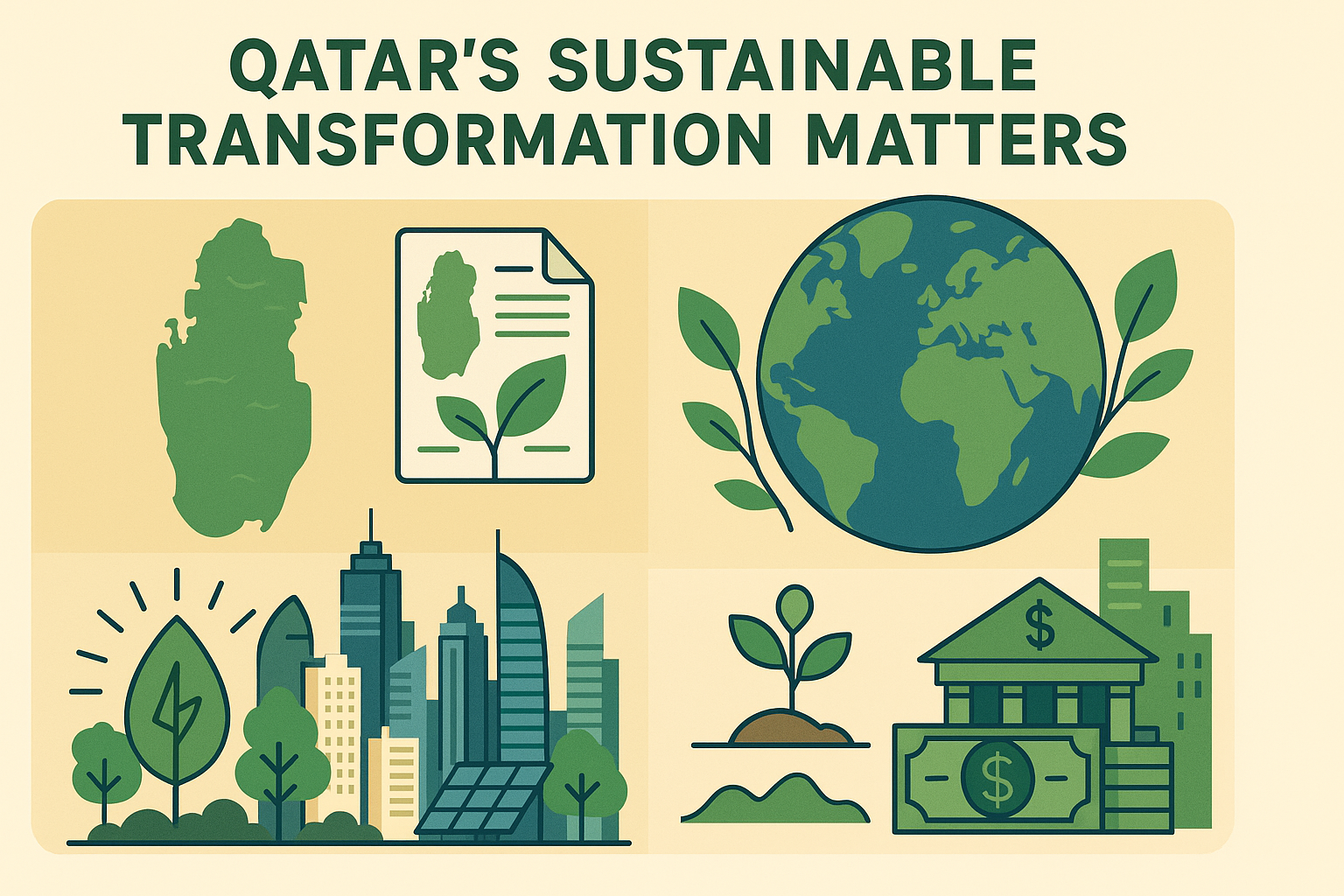Home / Blog / Qatar Sustainable Transformation: Building a Climate‑Resilient Future

Qatar’s journey toward a sustainable transformation is gaining remarkable momentum. From issuing hundreds of environmental permits to launching green finance frameworks and nation-wide climate workshops, the country is intentionally and strategically aligning itself with Qatar National Vision 2030. As a result, Qatar is evolving into an international model of resilience, balance, and environmental stewardship.
Why Qatar’s Sustainable Transformation Matters
Given the global climate crisis, Qatar’s shift toward sustainability is not optional—it’s essential. Moreover, because of its desert ecology and energy-driven economy, proactive steps are vital. In 2025 alone, several indicators show decisive progress:
- Issuance of 288 environment-related permits in Q1 2025 by the MECC
- Celebration of World Environment Day, emphasizing sustainability goals and Vision 2030
- Launch of the first-ever sustainable finance framework by the Qatar Central Bank
- Participation in global green summits like WGES 2025 and active climate adaptation workshops
MECC Issues 288 Environmental Permits in Q1 2025
First and foremost, in its commitment to environmental responsibility, the Ministry of Environment and Climate Change (MECC) issued 288 environmental permits during the first quarter of 2025. These permits range from construction oversight to industrial emissions monitoring, thus ensuring that economic development aligns with ecological preservation.
How This Supports Qatar Sustainable Transformation
By applying rigorous environmental standards, the MECC ensures that every new project drives progress without damaging natural habitats. Consequently, both public and private sectors must factor sustainability into operations, reinforcing long-term environmental health.
World Environment Day Highlights Climate Commitments
Then, on World Environment Day—5th June 2025—Qatar elevated global awareness by hosting events that reaffirmed its commitment to sustainability as guided by Vision 2030. Notably, the Undersecretary for Environmental Affairs emphasized continued investment in mitigation and adaptation efforts (QNA coverage).
Immediate and Ongoing Actions
First, educational campaigns engaged schools and communities. Meanwhile, practical steps—such as expanding green spaces and strengthening waste management—were reinstated. Together, these initiatives not only raised awareness but also initiated local commitments to environmental responsibility.
Climate Talks and Strategic Adaptation Workshops
Moreover, Qatar is actively participating in global dialogues. At WGES 2025 (World Green Economy Summit), Qatar supported a seven‑pillar sustainability framework (Zawya coverage).
Additionally, through a national workshop facilitated by GGGI, Qatar identified priority areas for climate adaptation—like coastal resilience and water conservation—ensuring a community-oriented vision (GGGI report).
Green Banking: Qatar Central Bank’s Sustainable Finance Framework
Importantly, sustainability in Qatar extends to the financial sector. In 2025, the Qatar Central Bank launched its first sustainable finance framework. Under this initiative, banks can issue green bonds, fund environmentally prioritized projects, and integrate ESG standards into lending policies.
Why It’s a Game Changer
- Aligns finance with environmental goals
- Encourages ESG-compliant corporate behavior
- Attracts international investors focused on sustainability
Local Initiatives: Smart Learning Cities & Community Engagement
At the same time, grassroots efforts are making a significant impact. In 2025, smart learning cities launched pilot projects to reduce energy usage in classrooms (Qatar Tribune report). These include integrated solar panels, smart temperature control systems, and waste-diversion initiatives—empowering students to become sustainability advocates.
Private Sector and NGO Collaboration
Beyond government agencies, private entities are stepping up. For instance, UAP Qatar rolled out its 2025 Green Initiative, featuring waste reduction goals and eco-friendly practices.
Similarly, Earthna hosted Summit 2025, addressing youth-led solutions for climate resilience (Earthna coverage), while Hundred.org spotlighted Qatar’s sustainable urban innovations (Hundred.org report).
The Bigger Picture: Qatar National Vision 2030 and ESG Priorities
Ultimately, Qatar’s sustainable transformation rests on strong policy frameworks. Crucially, the Qatar ESG Roadmap outlines strategies for carbon neutrality and climate resilience.
Therefore, sustainability isn’t an afterthought—it’s integrated into every level of policy, finance, education, and infrastructure.
What’s Next? A Path Forward
- Scale smart city pilots: Expand energy-efficient infrastructure in schools, hospitals, and public venues.
- Encourage green bonds: Support new issuances from both central bank and commercial entities.
- Engage communities: Involve youth and neighborhoods in climate monitoring and sustainability rewards.
- Measure and report: Publish annual ESG and climate adaptation progress consistent with GRI standards.
Conclusion: Qatar Leading in Sustainable Transformation
In short, Qatar’s sustainable transformation is evident not only in government policies and permitting reforms but also through climate summits, green finance innovation, and community-led projects. Consequently, Qatar is on track to become a regional and global model for balanced development.
Ultimately, it’s not just about policy—it’s about collective commitment. Because when the public, private, and civic sectors unite, true transformation happens. And with continued momentum, Qatar is on a path toward a safer, greener, and more resilient future.
[Sassy_Social_Share]